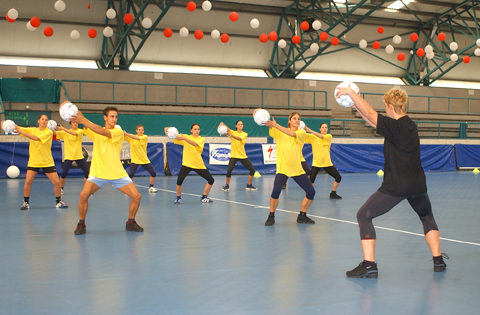Ballkorobics – a new form of movement in the palette of physical education
Hézsőné Böröcz Andrea
Ballkorobics is first and foremost a form of movement which improves rhythm and movement coordination. Its focus is on leg exercises combined with aerobics, step moves and their combinations, jumping jacks, and other elements.
The new form of exercise was introduced by Peter Schreiner, a former football player of the German national team, and then a DFA coach training new generations of footballers.
As a coach, he was working on how to make teaching and learning of ball control techniques more diverse and efficient, how to develop the sense of rhythm and how to implement all those goals in the form of an entertaining and cheerful work-out.
A new form of movement called Ballkorobics developed as an outcome of his cooperation with an aerobics trainer. He linked aerobics steps with different forms of ball throws, like kicks, snaps or dribbling.
Although he developed the sequence of moves specifically for football, this short presentation will demonstrate that its application can be much more widespread. Ballkorobics ball exercises can be successfully applied and practiced in any ball game training and also in physical education classes in schools.
Importantly, the ball, so favored by boys, will also make its appearance, so they will be willing to apply the exercises.
It is an excellent team building activity as it is important for participants to cooperate in order to successfully carry out some exercise types, and, last but not least, spectacular ballkorobics exercise performances can be launched.
Aerobic ball exercises improve arm and leg coordination, strengthen lower limb muscles, improve manual dexterity, develop peripheral vision, particularly when more balls are involved, and, least but not last, improve physical fitness.
The pupils do the exercises individually, in pairs, with one or two balls, and also in groups.
The exercises are available on designated videos, which were recorded with the collaboration of physical education teachers and trainers, as well as some students of Recreation Management at the Institute of Sport Sciences and Physical Education, SZTE JGYPK. I did not specifically prepare the students for these exercises, but explained or demonstrated the exercises during the video recording. Therefore perhaps not every presentation is perfect but my aim was to show the exercises in a real life situation.
How to prepare ballkorobics exercises in class:
Balls should be placed in nets or on top of cabinets before class sessions. It is important for a teacher to have his/her own ball, so that s/he does not ask students to demonstrate exercises. If possible, the balls should be of the same shape, weight, color and quality so that the overall impact is better, more visible and impressive.
The distribution of balls can be done in a number of ways:
- before the class starts, e.g. the students take the balls from the net before they line up
- when the class is in progress: students get the balls from the teacher or from an exempt student (it is not advisable to let students get the balls because they will start to select them, which is time-consuming)
Before the balls are distributed it is important to inform the students what they can and cannot do with the ball (they can throw it up but they cannot dribble or kick the ball)
The exercises can be done in the following formations:
- students form an open formation with full distance at bigger intervals
- students form a random formation
Other considerations:
- ball size should be adequate to match the students’ previous experience
- music should be selected adequately to the students’ age
- music volume should be motivating and encouraging dynamic performance

(At a football coach training in
The exercise descriptions and video presentations below are meant to offer help to those physical education colleagues who wish to try out new things and make their classes more vivid and varied. The exercises are demonstrated by physical education and training students who themselves are ‘beginners’ at ballkorobics.